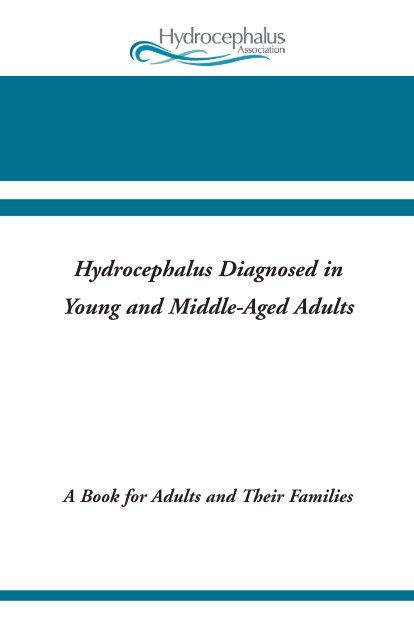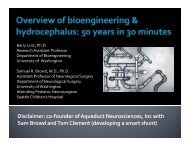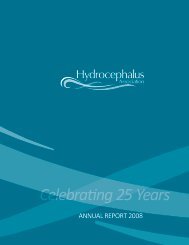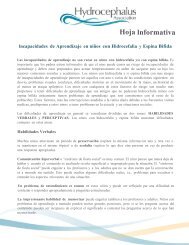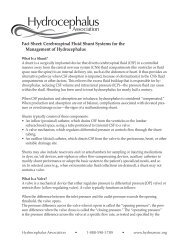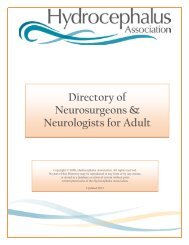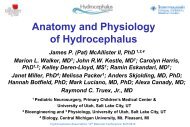Hydrocephalus Diagnosed in Young and Middle-Aged Adults
Hydrocephalus Diagnosed in Young and Middle-Aged Adults
Hydrocephalus Diagnosed in Young and Middle-Aged Adults
You also want an ePaper? Increase the reach of your titles
YUMPU automatically turns print PDFs into web optimized ePapers that Google loves.
<strong>Hydrocephalus</strong> <strong>Diagnosed</strong> <strong>in</strong><br />
<strong>Young</strong> <strong>and</strong> <strong>Middle</strong>-<strong>Aged</strong> <strong>Adults</strong><br />
A Book for <strong>Adults</strong> <strong>and</strong> Their Families
<strong>Hydrocephalus</strong> <strong>Diagnosed</strong> <strong>in</strong> <strong>Young</strong> <strong>and</strong> <strong>Middle</strong>-<strong>Aged</strong> <strong>Adults</strong>—A<br />
Book for <strong>Adults</strong> <strong>and</strong> Their Families was written for adults, their families<br />
<strong>and</strong> friends with the <strong>in</strong>tention of provid<strong>in</strong>g <strong>in</strong>formation about the<br />
diagnosis <strong>and</strong> treatment of hydrocephalus diagnosed <strong>in</strong> adulthood. It is<br />
a companion piece to our booklet About <strong>Hydrocephalus</strong>—A Book for<br />
Parents, the most widely distributed resource on <strong>in</strong>fant <strong>and</strong> childhood<br />
hydrocephalus <strong>in</strong> the United States.<br />
It is our belief that families <strong>and</strong> <strong>in</strong>dividuals deal<strong>in</strong>g with the complex<br />
issue of hydrocephalus diagnosed <strong>in</strong> young <strong>and</strong> middle-aged adults must<br />
become educated about the condition <strong>in</strong> order to make <strong>in</strong>formed decisions<br />
regard<strong>in</strong>g treatment <strong>and</strong> care. While each case differs, the <strong>in</strong>formation<br />
presented <strong>in</strong> this booklet is <strong>in</strong>tended to give a general overview of<br />
the condition without mak<strong>in</strong>g judgments or recommendations for <strong>in</strong>dividual<br />
care.<br />
hydrocephalus association<br />
san francisco, california<br />
second edition, january 2003
Editor: Rachel Fudge<br />
Illustrations: Lynne Larson © 2003<br />
Medical Consultants:<br />
Harold L. Rekate, M.D.<br />
Barrow Neurological Institute, Phoenix, AZ<br />
Michael A. Williams, M.D.<br />
Johns Hopk<strong>in</strong>s Hospital, Baltimore, MD<br />
Special thanks to our medical reviewers:<br />
Rick Abbott, M.D.; Alexa Canady, M.D.; <strong>and</strong> Joseph Piatt, M.D.<br />
The follow<strong>in</strong>g references were consulted <strong>in</strong> the writ<strong>in</strong>g of this booklet:<br />
Drs. J. A. Cowan, D. Rigamonti <strong>and</strong> M. A. Williams: “Cl<strong>in</strong>ically Dist<strong>in</strong>ct Syndrome<br />
of <strong>Hydrocephalus</strong> <strong>in</strong> <strong>Young</strong> <strong>and</strong> <strong>Middle</strong>-<strong>Aged</strong> <strong>Adults</strong>,” presented at<br />
the 3rd International <strong>Hydrocephalus</strong> Workshop, Kos, Greece, May 2001.<br />
Drs. G. P. Prigatano <strong>and</strong> H. L. Rekate: “Long-St<strong>and</strong><strong>in</strong>g Overt Ventriculomegaly<br />
of the Adult: Neuropsychological Considerations,” presented at the 6th National<br />
Conference on <strong>Hydrocephalus</strong>, Phoenix, AZ, May 2000.<br />
Drs. T. Fukuhara <strong>and</strong> M. Luciano: “Cl<strong>in</strong>ical Features of Late-Onset Idiopathic Aqueductal<br />
Stenosis,” Surgical Neurology 2001; 55: 132–7.<br />
Drs. N. Buxton, D. Macarthur, M. Vloeberghs, J. Punt, I. Robertson: “Neuroendoscopic<br />
Third Ventriculostomy for <strong>Hydrocephalus</strong> <strong>in</strong> <strong>Adults</strong>: Report of a<br />
S<strong>in</strong>gle Unit’s Experience with 63 Cases,” Surgical Neurology 2001; 55: 74–8.<br />
Publication of this booklet was made possible by a generous grant from the George H.<br />
S<strong>and</strong>y Foundation.<br />
© 2003 <strong>Hydrocephalus</strong> Association, San Francisco, California<br />
All rights reserved. No part of this booklet may be used or reproduced <strong>in</strong> any form or by<br />
any means, or stored <strong>in</strong> a database or retrieval system, without prior written permission<br />
of the <strong>Hydrocephalus</strong> Association. Mak<strong>in</strong>g copies of this booklet is aga<strong>in</strong>st the law. Additional<br />
copies of this booklet may be obta<strong>in</strong>ed for a small fee from the <strong>Hydrocephalus</strong><br />
Association.
<strong>Hydrocephalus</strong> <strong>Diagnosed</strong> <strong>in</strong><br />
<strong>Young</strong> <strong>and</strong> <strong>Middle</strong>-<strong>Aged</strong> <strong>Adults</strong>
Introduction<br />
For many years, people with hydrocephalus, their families <strong>and</strong> their<br />
doctors have worked unceas<strong>in</strong>gly to <strong>in</strong>crease public awareness of<br />
hydrocephalus, its causes <strong>and</strong> its treatment. In the past half-century,<br />
great advances have been made <strong>in</strong> the diagnosis <strong>and</strong> treatment of hydrocephalus,<br />
especially as it occurs <strong>in</strong> <strong>in</strong>fants. Normal pressure hydrocephalus<br />
(NPH), which occurs primarily <strong>in</strong> the elderly, is now receiv<strong>in</strong>g a<br />
great deal of media <strong>and</strong> medical attention, lead<strong>in</strong>g to more efficient <strong>and</strong><br />
timely diagnosis <strong>and</strong> treatment. <strong>Hydrocephalus</strong> is now regularly detected<br />
<strong>in</strong> utero, before the baby is born. New treatment protocols, <strong>in</strong>clud<strong>in</strong>g<br />
advances <strong>in</strong> shunt <strong>and</strong> endoscopic technology, make it more<br />
likely than ever that people with hydrocephalus—whether diagnosed <strong>in</strong><br />
<strong>in</strong>fancy or adulthood—will live full, rich lives.<br />
Despite these advances over the past 50 years, there is still much to<br />
be learned about hydrocephalus <strong>and</strong> the subtle forms it can take. Even<br />
now, hydrocephalus is most commonly understood to occur <strong>in</strong> <strong>in</strong>fants<br />
or the elderly—at the extremes of life. But <strong>in</strong> actuality, hydrocephalus<br />
can occur at any time <strong>in</strong> life, <strong>and</strong> as a result of a variety of causes. And<br />
now doctors are beg<strong>in</strong>n<strong>in</strong>g to identify <strong>and</strong> describe a dist<strong>in</strong>ct form of<br />
hydrocephalus that arises <strong>in</strong> young <strong>and</strong> middle-aged adults.<br />
Vastly different from hydrocephalus diagnosed <strong>in</strong> <strong>in</strong>fancy <strong>and</strong> early<br />
childhood, or adult-onset normal pressure hydrocephalus found <strong>in</strong> older<br />
adults (typically age 60 <strong>and</strong> older), hydrocephalus <strong>in</strong> young <strong>and</strong> middleaged<br />
adults is a unique <strong>and</strong> often confus<strong>in</strong>g condition. Though it has<br />
only recently begun to receive formal attention from the medical community,<br />
hydrocephalus <strong>in</strong> this age group presents a host of challenges<br />
<strong>and</strong> opportunities for patients <strong>and</strong> medical professionals alike. The challenge<br />
goes far beyond rout<strong>in</strong>e or specialized medical care, encompass<strong>in</strong>g<br />
psychosocial, emotional <strong>and</strong> occupational issues, all of which will be<br />
discussed <strong>in</strong> this booklet.<br />
5
A Note on Term<strong>in</strong>ology<br />
Medical professionals are only just beg<strong>in</strong>n<strong>in</strong>g to identify <strong>and</strong> describe<br />
the dist<strong>in</strong>ct syndrome of hydrocephalus <strong>in</strong> adults. As yet, there is no<br />
universally agreed-upon term, such as normal pressure hydrocephalus,<br />
to describe this population. We have chosen to use the term co<strong>in</strong>ed by<br />
Michael A. Williams, M.D.: the syndrome of hydrocephalus <strong>in</strong> young<br />
<strong>and</strong> middle-aged adults (SHYMA). Other terms used to describe this<br />
<strong>and</strong> similar populations are late-onset idiopathic aqueductal stenosis,<br />
longst<strong>and</strong><strong>in</strong>g overt ventriculomegaly of the adult, <strong>and</strong> late-onset aqueductal<br />
stenosis.<br />
About This Booklet<br />
Some of the <strong>in</strong>formation <strong>in</strong> this booklet is adapted or repr<strong>in</strong>ted from<br />
About <strong>Hydrocephalus</strong>—A Book for Families <strong>and</strong> from other materials<br />
published by the <strong>Hydrocephalus</strong> Association. We beg<strong>in</strong> with a detailed<br />
description of hydrocephalus <strong>in</strong> general, <strong>in</strong>clud<strong>in</strong>g its causes. Chapter 2<br />
discusses symptoms <strong>and</strong> diagnosis, <strong>and</strong> Chapter 3 provides <strong>in</strong>formation<br />
about treatment of hydrocephalus. Social <strong>and</strong> emotional issues result<strong>in</strong>g<br />
from SHYMA are outl<strong>in</strong>ed <strong>in</strong> Chapter 4. At the very end is a detailed<br />
list of further resources to consult.<br />
This is our first attempt to provide a detailed overview of SHYMA.<br />
Because this condition is only just beg<strong>in</strong>n<strong>in</strong>g to be understood <strong>and</strong><br />
identified, we realize that we all have much to learn. A revised edition<br />
will almost certa<strong>in</strong>ly be published with<strong>in</strong> the next few years, as SHYMA<br />
becomes better understood. We welcome your feedback.<br />
6
1 ~ About <strong>Hydrocephalus</strong><br />
Anatomy <strong>and</strong> Physiology<br />
The Bra<strong>in</strong>, Sp<strong>in</strong>al Cord <strong>and</strong> Their Protective Cover<strong>in</strong>gs<br />
The bra<strong>in</strong> <strong>and</strong> sp<strong>in</strong>al cord form the central nervous system. These vital<br />
structures are surrounded <strong>and</strong> protected by the bones of the skull <strong>and</strong><br />
the vertebral column. The bones of the skull are often referred to as the<br />
cranium. The places where the bones meet <strong>and</strong> grow are called sutures.<br />
The vertebral column, which encases the entire sp<strong>in</strong>al cord, is composed<br />
of bones called vertebrae. The sp<strong>in</strong>al column beg<strong>in</strong>s at the base of the<br />
skull <strong>and</strong> extends all the way to the tail bone.<br />
The bra<strong>in</strong>’s major components are the cerebrum, the cerebellum <strong>and</strong><br />
the bra<strong>in</strong> stem. The cerebrum is the central process<strong>in</strong>g area for the<br />
body’s <strong>in</strong>com<strong>in</strong>g <strong>and</strong> outgo<strong>in</strong>g messages. It is also the area responsible<br />
for speech, thought <strong>and</strong> memory. The cerebellum primarily helps coord<strong>in</strong>ate<br />
our body movements. The bra<strong>in</strong> stem controls basic functions<br />
like heart rate, breath<strong>in</strong>g <strong>and</strong> blood pressure. The sp<strong>in</strong>al cord extends<br />
from the bra<strong>in</strong> stem, through a very large open<strong>in</strong>g (the foramen magnum)<br />
<strong>in</strong> the base of the skull, <strong>and</strong> down the sp<strong>in</strong>e. At the level of each<br />
vertebra <strong>in</strong> the sp<strong>in</strong>e, nerve fibers arise from the sp<strong>in</strong>al cord <strong>and</strong> emerge<br />
through open<strong>in</strong>gs between the vertebrae. These are the sp<strong>in</strong>al nerves,<br />
which carry messages to <strong>and</strong> from various regions of our bodies.<br />
Ly<strong>in</strong>g between the bra<strong>in</strong> <strong>and</strong> skull are three protective cover<strong>in</strong>gs.<br />
These are the membranes (men<strong>in</strong>ges), which completely surround the<br />
bra<strong>in</strong> <strong>and</strong> sp<strong>in</strong>al cord. An important fluid—the cerebrosp<strong>in</strong>al fluid<br />
(CSF)—flows <strong>in</strong> a space between these membranes called the subarachnoid<br />
space. CSF is <strong>in</strong> constant circulation <strong>and</strong> serves several important<br />
functions. Because it surrounds the bra<strong>in</strong> <strong>and</strong> sp<strong>in</strong>al cord, CSF acts as a<br />
protective cushion aga<strong>in</strong>st blows to the head <strong>and</strong> sp<strong>in</strong>e. Though it is<br />
clear <strong>and</strong> colorless, CSF conta<strong>in</strong>s many nutrients <strong>and</strong> prote<strong>in</strong>s that are<br />
needed for the nourishment <strong>and</strong> normal function of the bra<strong>in</strong>. It also<br />
carries waste products away from surround<strong>in</strong>g tissues.<br />
7
Ventricles<br />
CSF is produced with<strong>in</strong> the cavities of the bra<strong>in</strong> that are called ventricles.<br />
Imag<strong>in</strong>e the ventricles as chambers filled with fluid. There are four <strong>in</strong> all:<br />
the two lateral ventricles, the third ventricle <strong>and</strong> the fourth ventricle. The<br />
ventricles are <strong>in</strong>terconnected by narrow passageways. Your neurosurgeon<br />
or neurologist can learn valuable <strong>in</strong>formation about your condition by<br />
closely monitor<strong>in</strong>g the size <strong>and</strong> shape of these ventricles as shown by CT<br />
or MRI scans.<br />
Cerebrosp<strong>in</strong>al Fluid Circulation <strong>and</strong> Absorption<br />
CSF is formed with<strong>in</strong> the ventricles by small, delicate tufts of specialized<br />
tissue called the choroid plexus. Beg<strong>in</strong>n<strong>in</strong>g <strong>in</strong> the lateral ventricles, CSF<br />
flows through passageways <strong>in</strong>to the third ventricle. From the third ventricle<br />
it flows down a long, narrow passageway (the aqueduct of Sylvius)<br />
<strong>in</strong>to the fourth ventricle. From the fourth ventricle it passes through three<br />
small open<strong>in</strong>gs (foram<strong>in</strong>a) <strong>in</strong>to the subarachnoid space surround<strong>in</strong>g the<br />
bra<strong>in</strong> <strong>and</strong> sp<strong>in</strong>al cord. Most of the CSF is absorbed through t<strong>in</strong>y, specialized<br />
cell clusters (arachnoid villi) near the top <strong>and</strong> midl<strong>in</strong>e of the bra<strong>in</strong>.<br />
CSF passes through the arachnoid villi <strong>in</strong>to a large ve<strong>in</strong> (the superior sagittal<br />
s<strong>in</strong>us) <strong>and</strong> is absorbed <strong>in</strong>to the bloodstream. The ventricular system<br />
is the major pathway for the flow of CSF.<br />
<strong>Hydrocephalus</strong><br />
Our bodies produce approximately a p<strong>in</strong>t (500 ml) of CSF daily, cont<strong>in</strong>uously<br />
replac<strong>in</strong>g CSF as it is absorbed. Under normal conditions<br />
there is a delicate balance between the rate at which CSF is produced<br />
<strong>and</strong> the rate at which it is absorbed. <strong>Hydrocephalus</strong> occurs when this<br />
balance is disrupted <strong>and</strong> the rate of absorption is less than the rate of<br />
production. Although there are many factors that can disrupt this balance,<br />
the most common is a blockage, or obstruction, somewhere along<br />
the circulatory pathway of CSF. The obstruction may develop from a<br />
variety of causes, such as bra<strong>in</strong> tumors, cysts, scarr<strong>in</strong>g <strong>and</strong> <strong>in</strong>fection.<br />
Specific causes will be discussed more fully below.<br />
Because CSF is produced cont<strong>in</strong>uously, when its flow is blocked it<br />
will beg<strong>in</strong> to accumulate upstream from the site of the obstruction,<br />
8
Arachnoid villi<br />
Subarachnoid space<br />
Aqueduct of Sylvius<br />
Lateral ventricle<br />
Sagittal s<strong>in</strong>us<br />
Choroid plexus<br />
Third ventricle<br />
Fourth ventricle<br />
Cerebrosp<strong>in</strong>al fluid (CSF) circulatory pathway: The draw<strong>in</strong>g<br />
shows a view of the bra<strong>in</strong>. The black arrows show the major pathway<br />
of CSF flow. The gray arrows show additional pathways.<br />
9
much like a river swells beh<strong>in</strong>d a dam. Eventually, as the amount of fluid<br />
accumulates, it causes the ventricles to enlarge <strong>and</strong> pressure to <strong>in</strong>crease<br />
<strong>in</strong>side the head. This condition is known as hydrocephalus.<br />
Obstruction of the CSF pathway often occurs with<strong>in</strong> the ventricles.<br />
Although it can occur anywhere <strong>in</strong> the ventricular system, the site of blockage<br />
usually lies either with<strong>in</strong> the narrow passageways connect<strong>in</strong>g the ventricles<br />
or where the CSF exits the fourth ventricle <strong>in</strong>to the subarachnoid<br />
space. For example, because of its long, narrow structure, the aqueduct of<br />
Sylvius is especially vulnerable to becom<strong>in</strong>g narrowed or obstructed so that<br />
it blocks the flow of CSF. Likewise, when the small open<strong>in</strong>gs of the fourth<br />
ventricle fail to develop, or develop improperly, they also may obstruct the<br />
flow of CSF. <strong>Hydrocephalus</strong> of this k<strong>in</strong>d is called noncommunicat<strong>in</strong>g or<br />
obstructive hydrocephalus because the ventricles no longer provide free<br />
passage of CSF through them <strong>in</strong>to the subarachnoid space.<br />
Another type of hydrocephalus is communicat<strong>in</strong>g or extraventricular<br />
obstructive hydrocephalus. It usually results from a thicken<strong>in</strong>g of the<br />
arachnoid around the base of the bra<strong>in</strong>, which blocks the flow of CSF<br />
from the sp<strong>in</strong>al to the cortical subarachnoid spaces. CSF flows unrestricted<br />
through the ventricles, but a blockage between the sp<strong>in</strong>e <strong>and</strong> the<br />
fluid around the outside of the bra<strong>in</strong> prevents the free flow of CSF<br />
through the subarachnoid space.<br />
Etiology (Causes)<br />
<strong>Hydrocephalus</strong> that is congenital (present at birth) is thought to be<br />
caused by a complex <strong>in</strong>teraction of environmental <strong>and</strong> perhaps genetic<br />
factors. (Aqueductal stenosis <strong>and</strong> sp<strong>in</strong>a bifida are two examples.) Some<br />
people with SHYMA are classified as hav<strong>in</strong>g decompensated congenital<br />
hydrocephalus. That is, the hydrocephalus may have been present<br />
at birth, <strong>and</strong> perhaps even treated <strong>in</strong> early childhood, but rema<strong>in</strong>ed<br />
largely compensated <strong>and</strong> asymptomatic for many years. Congenital hydrocephalus<br />
can be diagnosed by assess<strong>in</strong>g head circumference. If the<br />
head circumference is significantly larger than normal, accord<strong>in</strong>g to<br />
st<strong>and</strong>ard charts <strong>and</strong> references, it is reasonable to suspect that hydrocephalus<br />
has been present s<strong>in</strong>ce <strong>in</strong>fancy, even though it may not have<br />
been symptomatic <strong>in</strong> <strong>in</strong>fancy.<br />
10
Acquired hydrocephalus arises after birth, <strong>and</strong> results from <strong>in</strong>traventricular<br />
hemorrhage, men<strong>in</strong>gitis, head trauma, encephalitis, tumors or<br />
cysts.<br />
Sometimes doctors are unable to p<strong>in</strong>po<strong>in</strong>t the cause of the hydrocephalus.<br />
In this case, the hydrocephalus is deemed to be idiopathic,<br />
mean<strong>in</strong>g with no known cause.<br />
It is not known whether genetic factors play any role <strong>in</strong> SHYMA,<br />
although <strong>in</strong>herited forms of hydrocephalus are virtually unknown.<br />
The causes of SHYMA are similar to the causes of hydrocephalus at<br />
all ages, <strong>in</strong>clud<strong>in</strong>g processes that obstruct the ventricles, such as cysts or<br />
tumors, <strong>and</strong> processes that impair the flow of sp<strong>in</strong>al fluid through the<br />
subarachnoid space, such as men<strong>in</strong>gitis, encephalitis, concussion, head<br />
<strong>in</strong>jury, or certa<strong>in</strong> strokes <strong>and</strong> bra<strong>in</strong> hemorrhages.<br />
<strong>Hydrocephalus</strong> does not always occur immediately after one of these<br />
predispos<strong>in</strong>g conditions has occurred. In many <strong>in</strong>stances, years or decades<br />
may pass before the symptoms of SHYMA become evident.<br />
11
2 ~ Symptoms & Diagnosis<br />
The symptoms of SHYMA are similar <strong>in</strong> some ways to those of normal<br />
pressure hydrocephalus (NPH) <strong>in</strong> the elderly, but are often<br />
much more subtle. And yet they can have a most profound effect on<br />
patients’ lives, render<strong>in</strong>g them unable to work or to have difficulty function<strong>in</strong>g<br />
<strong>in</strong> day-to-day life.<br />
Although the medical literature describ<strong>in</strong>g SHYMA <strong>and</strong> related conditions<br />
is limited, it appears that diagnosis is often difficult, caus<strong>in</strong>g<br />
physical <strong>and</strong> mental distress <strong>and</strong> possibly serious long-term health problems<br />
due to an extended period of pressure on the bra<strong>in</strong>. Sometimes,<br />
symptoms are disregarded as manifestations of mid-life crisis or other<br />
psychological/emotional issues. Additionally, as symptoms worsen <strong>and</strong><br />
the condition goes undiagnosed, one’s ability to function at work can be<br />
affected, <strong>and</strong> employment can be compromised.<br />
Symptoms<br />
The most common symptoms of SHYMA are disturbances <strong>in</strong> gait, cognition<br />
<strong>and</strong> bladder control. Chronic headaches are also frequently reported.<br />
Gait disturbances <strong>in</strong>clude a sense of clums<strong>in</strong>ess, <strong>and</strong> difficulty walk<strong>in</strong>g<br />
on uneven surfaces or stairs. Subtle gait abnormalities may be seen<br />
dur<strong>in</strong>g a careful exam<strong>in</strong>ation, but obvious gait impairment or apraxia is<br />
rare.<br />
Cognitive compla<strong>in</strong>ts are often described as “dullness,” decl<strong>in</strong>e <strong>in</strong><br />
organizational skills <strong>and</strong> dependence on lists, <strong>and</strong> may lead to difficulty<br />
with job duties. And <strong>in</strong> fact, a great number of people with SHYMA<br />
report that their symptoms resulted <strong>in</strong> decreased job performance. Depend<strong>in</strong>g<br />
on the length of time hydrocephalus has gone untreated, cognitive<br />
decl<strong>in</strong>e can vary greatly.<br />
12
Chronic headaches that are hard to relieve with pa<strong>in</strong> medications<br />
(such as aspir<strong>in</strong> or acetam<strong>in</strong>ophen) are also frequently reported. Other<br />
symptoms <strong>in</strong>clude visual compla<strong>in</strong>ts <strong>and</strong> syncope (fa<strong>in</strong>t<strong>in</strong>g).<br />
Patients’ compla<strong>in</strong>ts are often quite prom<strong>in</strong>ent, <strong>in</strong> contrast to the<br />
doctors’ cl<strong>in</strong>ical f<strong>in</strong>d<strong>in</strong>gs, which can be subtle—a discrepancy that may<br />
impede accurate diagnosis of SHYMA. The average time to diagnose—<br />
that is, the time between the onset of symptoms <strong>and</strong> a diagnosis of hydrocephalus—appears<br />
to be significant, <strong>and</strong> is often years.<br />
Some people with SHYMA may have been diagnosed with hydrocephalus<br />
as children or <strong>in</strong>fants, <strong>and</strong> perhaps even shunted, yet displayed<br />
no further symptoms <strong>and</strong> hence were not treated for years. Perhaps their<br />
shunts malfunctioned or stopped work<strong>in</strong>g somewhere along the way,<br />
sett<strong>in</strong>g the stage for a relapse of symptoms. The slow, <strong>in</strong>sidious return of<br />
hydrocephalus symptoms <strong>in</strong> SHYMA suggests that the hydrocephalus<br />
was probably compensated at the time of shunt obstruction, <strong>and</strong> it is<br />
only with the passage of time (sometimes years) that decompensation<br />
occurs <strong>and</strong> symptoms re-emerge. If the hydrocephalus were not compensated,<br />
then shunt obstruction would produce fairly rapid onset of<br />
hydrocephalus symptoms. The first generation of children shunted for<br />
hydrocephalus <strong>in</strong> the 1950s <strong>and</strong> ’60s may be at particular risk for<br />
SHYMA, as some of them may not have received any neurosurgical care<br />
s<strong>in</strong>ce childhood.<br />
The degree of symptoms <strong>and</strong> their resultant effect varies widely<br />
among patients. If symptoms have been present for years, the patient<br />
may be more seriously disabled. Early diagnosis can be a factor <strong>in</strong> successful<br />
resolution of symptoms.<br />
Diagnosis<br />
SHYMA is diagnosed us<strong>in</strong>g a comb<strong>in</strong>ation of bra<strong>in</strong> scans, <strong>in</strong>tracranial<br />
pressure monitor<strong>in</strong>g <strong>and</strong> cl<strong>in</strong>ical evaluation of symptoms.<br />
Once symptoms of gait disturbance, mild dementia or bladder control<br />
have been identified, a physician who suspects hydrocephalus may<br />
13
ecommend one or more additional tests. At this po<strong>in</strong>t <strong>in</strong> the diagnostic<br />
process, it is important that a neurologist <strong>and</strong> a neurosurgeon become<br />
part of your medical team, along with your primary care physician.<br />
Their <strong>in</strong>volvement from the diagnostic stage onward is helpful not only<br />
<strong>in</strong> <strong>in</strong>terpret<strong>in</strong>g test results <strong>and</strong> select<strong>in</strong>g likely c<strong>and</strong>idates for shunt<strong>in</strong>g<br />
but also <strong>in</strong> discuss<strong>in</strong>g the actual surgery <strong>and</strong> follow-up care, as well as<br />
expectations of surgery. The decision to order a given test may depend<br />
on the specific cl<strong>in</strong>ical situation, as well as the preference <strong>and</strong> experience<br />
of your medical team.<br />
These tests may <strong>in</strong>clude computerized tomography (CT), magnetic<br />
resonance imag<strong>in</strong>g (MRI), lumbar puncture, cont<strong>in</strong>uous lumbar CSF<br />
dra<strong>in</strong>age, <strong>in</strong>tracranial pressure (ICP) monitor<strong>in</strong>g, measurement of cerebrosp<strong>in</strong>al<br />
fluid outflow resistance or isotopic cisternography. Neuropsychological<br />
evaluation may also be recommended.<br />
CT Scan<br />
CT is a picture of the bra<strong>in</strong> created by us<strong>in</strong>g x-rays <strong>and</strong> a special scanner.<br />
It is safe, reliable, pa<strong>in</strong>less <strong>and</strong> relatively quick (about 15 m<strong>in</strong>utes). An<br />
x-ray beam passes through the head, allow<strong>in</strong>g a computer to make a<br />
picture of the bra<strong>in</strong>. A CT will show if the ventricles are enlarged or if<br />
there is obvious blockage.<br />
Unexpected enlargement of the ventricles is often the first clue that<br />
SHYMA may be present, but this f<strong>in</strong>d<strong>in</strong>g alone is usually not a sufficient<br />
reason to proceed to surgical therapy. It is important to remember that<br />
hydrocephalus can be compensated or uncompensated, <strong>and</strong> further test<strong>in</strong>g<br />
is often needed. It is potentially harmful to put a shunt <strong>in</strong>to a person<br />
with compensated hydrocephalus, just as it is potentially harmful not to<br />
put a shunt <strong>in</strong>to a person with decompensated hydrocephalus.<br />
MRI<br />
MRI is also safe <strong>and</strong> pa<strong>in</strong>less, but it will take longer than 15 m<strong>in</strong>utes.<br />
MRI uses radio signals <strong>and</strong> a very powerful magnet to create a picture<br />
of the bra<strong>in</strong>. Aga<strong>in</strong>, it will be possible to detect if the ventricles are enlarged<br />
as well as evaluate the CSF flow <strong>and</strong> provide <strong>in</strong>formation about<br />
the surround<strong>in</strong>g bra<strong>in</strong> tissues. (The MRI provides more <strong>in</strong>formation<br />
than the CT, <strong>and</strong> is therefore the test of choice <strong>in</strong> most cases.) MRI scans<br />
14
can also assess how CSF moves through a particular part of the bra<strong>in</strong><br />
called the cerebral aqueduct (“the CSF flow void sign”).<br />
In idiopathic forms of hydrocephalus, it is essential to perform an MRI<br />
with <strong>and</strong> without contrast enhancement. This allows the doctor to look<br />
for subtle signs of tumor or chronic <strong>in</strong>fection, which can cause adult-onset<br />
hydrocephalus <strong>and</strong> which may require additional treatment besides shunt<br />
surgery.<br />
Lumbar Puncture<br />
Lumbar puncture, or sp<strong>in</strong>al tap, allows an estimation of CSF pressure<br />
<strong>and</strong> analysis of the fluid. Under local anesthetic, a th<strong>in</strong> needle is passed<br />
<strong>in</strong>to the sp<strong>in</strong>al fluid space of the low back. Removal of up to 50 cc of<br />
CSF is done to see if symptoms are temporarily relieved. If removal of<br />
some CSF dramatically improves symptoms, even temporarily, then<br />
surgical treatment may be successful. The use of a lumbar puncture as a<br />
screen<strong>in</strong>g test for SHYMA is not advocated by all physicians, s<strong>in</strong>ce many<br />
patients who experience little or no improvement after the test may still<br />
improve with a shunt.<br />
This test is extremely important if the cause of the hydrocephalus is<br />
not obvious. Occult <strong>in</strong>fections or tumors with CSF spread may be<br />
found from cultur<strong>in</strong>g <strong>and</strong> analyz<strong>in</strong>g the CSF for tuberculosis or fungi.<br />
Lumbar catheter <strong>in</strong>sertion is a variation of the lumbar puncture. A<br />
sp<strong>in</strong>al needle is <strong>in</strong>serted <strong>in</strong> the sp<strong>in</strong>al fluid space of the low back, then a<br />
th<strong>in</strong>, flexible tube (catheter) is passed <strong>in</strong>to the sp<strong>in</strong>al fluid <strong>and</strong> the needle<br />
is removed. The lumbar catheter allows for cont<strong>in</strong>uous <strong>and</strong> more accurate<br />
record<strong>in</strong>g of sp<strong>in</strong>al fluid pressure, or for cont<strong>in</strong>uous removal of<br />
sp<strong>in</strong>al fluid over several days to imitate the effect that a shunt would<br />
have. Patients who respond dramatically to such sp<strong>in</strong>al fluid dra<strong>in</strong>age are<br />
likely to respond to shunt surgery. Lumbar catheter <strong>in</strong>sertion requires<br />
hospitalization.<br />
Intracranial Pressure Monitor<strong>in</strong>g<br />
Intracranial pressure monitor<strong>in</strong>g requires admission to the hospital. A<br />
small pressure monitor is <strong>in</strong>serted through the skull <strong>in</strong>to the bra<strong>in</strong> or<br />
ventricles to measure the ICP. The pressure is not always high, <strong>and</strong> con-<br />
15
t<strong>in</strong>uous pressure monitor<strong>in</strong>g over 24 or 48 hours (either by the lumbar<br />
catheter or the <strong>in</strong>tracranial method) may be necessary to detect an abnormal<br />
pattern of pressure waves.<br />
The measurement of CSF outflow resistance is a more <strong>in</strong>volved test<br />
that requires a specialized hospital sett<strong>in</strong>g. In essence, this test assesses the<br />
degree of blockage to CSF absorption back <strong>in</strong>to the bloodstream. It requires<br />
the simultaneous <strong>in</strong>fusion of artificial sp<strong>in</strong>al fluid <strong>and</strong> measurement<br />
of CSF pressure. If the calculated resistance value is abnormally high, then<br />
there is a very good chance that the patient will improve with shunt surgery.<br />
Isotopic Cisternography<br />
Isotopic cisternography <strong>in</strong>volves hav<strong>in</strong>g a radioactive isotope <strong>in</strong>jected<br />
<strong>in</strong>to the lumbar subarachnoid space (lower back) through a sp<strong>in</strong>al tap.<br />
This allows the absorption of CSF to be evaluated over a period of time<br />
(up to 96 hours) by periodic scann<strong>in</strong>g. This will determ<strong>in</strong>e whether the<br />
isotope is be<strong>in</strong>g absorbed over the surface of the bra<strong>in</strong> or rema<strong>in</strong>s<br />
trapped <strong>in</strong>side the ventricles. Isotopic cisternography <strong>in</strong>volves lumbar<br />
puncture <strong>and</strong> is considerably more <strong>in</strong>volved than either the CT or MRI.<br />
This test has become less popular because a “positive” cisternogram result<br />
does not reliably predict whether a patient will respond to shunt<br />
surgery. Its utility <strong>in</strong> SHYMA is not known.<br />
Neuropsychological Test<strong>in</strong>g<br />
Neuropsychology is the study of bra<strong>in</strong>-behavior relationships. When a<br />
patient’s primary problems <strong>in</strong>clude th<strong>in</strong>k<strong>in</strong>g, emotion <strong>and</strong> behavior,<br />
neuropsychological evaluation can be an important complement to<br />
cl<strong>in</strong>ical work <strong>in</strong> mak<strong>in</strong>g a diagnosis. An evaluation can also help family<br />
members <strong>and</strong> physicians underst<strong>and</strong> the impact of hydrocephalus on a<br />
patient’s everyday function.<br />
A neuropsychological assessment typically <strong>in</strong>cludes a thorough <strong>in</strong>terview<br />
with the patient <strong>and</strong> one or more family members, as well as a close<br />
review of medical records <strong>and</strong> studies. A series of tests is adm<strong>in</strong>istered to<br />
assess various aspects of cognitive function, <strong>in</strong>clud<strong>in</strong>g attention, memory,<br />
language, visual-spatial ability <strong>and</strong> executive function (the ability to<br />
reason, plan <strong>and</strong> modulate behavior). The ultimate goal is to underst<strong>and</strong><br />
16
how changes <strong>in</strong> bra<strong>in</strong> structure <strong>and</strong> function are affect<strong>in</strong>g the patient’s<br />
behavior.<br />
In the case of SHYMA, neuropsychological test<strong>in</strong>g can help determ<strong>in</strong>e<br />
whether or not a patient would benefit from immediate surgical<br />
<strong>in</strong>tervention or should simply be monitored for a longer period.<br />
17
3 ~ Treatment<br />
In many cases, prompt treatment can reverse many of the symptoms<br />
of hydrocephalus, restor<strong>in</strong>g much cognitive <strong>and</strong> physical function<strong>in</strong>g.<br />
If left untreated, however, symptoms can become quite disabl<strong>in</strong>g, lead<strong>in</strong>g<br />
to severe cognitive <strong>and</strong> physical decl<strong>in</strong>e. It appears that the length of time<br />
between onset of symptoms <strong>and</strong> diagnosis is a factor <strong>in</strong> the success of<br />
treatment. Another, as yet unmeasurable, factor that affects the outcome<br />
of treatment is the extent of reversible versus irreversible bra<strong>in</strong> <strong>in</strong>jury<br />
caused by hydrocephalus. Treatment is most successful when little irreversible<br />
<strong>in</strong>jury has occurred. Transient improvement of symptoms after lumbar<br />
puncture or sp<strong>in</strong>al fluid dra<strong>in</strong>age by lumbar catheter is one way to<br />
demonstrate that some of the bra<strong>in</strong> <strong>in</strong>jury is still reversible.<br />
Shunt<strong>in</strong>g<br />
The most common treatment for SHYMA, as with all forms of hydrocephalus,<br />
is shunt<strong>in</strong>g. A shunt is a flexible tube placed <strong>in</strong>to the ventricular<br />
system that diverts the flow of CSF <strong>in</strong>to another region of the body<br />
where it can be absorbed, such as the peritoneal (abdom<strong>in</strong>al) cavity or<br />
the right atrium of the heart. The shunt tube is about one-eighth <strong>in</strong>ch<br />
<strong>in</strong> diameter <strong>and</strong> is made of a soft <strong>and</strong> pliable plastic that is well tolerated<br />
by our body tissues. Shunt systems come <strong>in</strong> a variety of models but have<br />
similar functional components. Catheters (tub<strong>in</strong>g) <strong>and</strong> a flow-control<br />
mechanism (one-way valve) are components common to all shunts. The<br />
valve <strong>in</strong> the shunt ma<strong>in</strong>ta<strong>in</strong>s the CSF at normal pressure with<strong>in</strong> the<br />
ventricles.<br />
The surgical placement of a shunt, which is performed by a neurosurgeon,<br />
is a relatively short procedure. The patient is brought to the<br />
operat<strong>in</strong>g room <strong>and</strong> is placed under general anesthesia. A small region<br />
of the scalp may be clipped or shaved, <strong>and</strong>, for a ventriculoperitoneal<br />
shunt, the entire area from the scalp to the abdomen is scrubbed with<br />
an antiseptic solution. Sterile drapes are placed over the patient. Incisions<br />
are made <strong>in</strong> the head <strong>and</strong> abdom<strong>in</strong>al areas. The shunt tube is<br />
passed beneath the sk<strong>in</strong>, <strong>in</strong> the fatty tissue that lies just below the sk<strong>in</strong>.<br />
18
Valve<br />
Collection catheter<br />
Lateral ventricle<br />
With the VP shunt <strong>in</strong> place, cerebrosp<strong>in</strong>al fluid (CSF) flows <strong>in</strong>to the<br />
collection catheter <strong>and</strong> down the exit catheter, which shunts the fluid<br />
<strong>in</strong>to the peritoneal cavity.<br />
19
A small hole is made <strong>in</strong> the skull, <strong>and</strong> the membranes between the skull<br />
<strong>and</strong> bra<strong>in</strong> are opened. The ventricular end of the shunt is gently passed<br />
through the bra<strong>in</strong> <strong>in</strong>to the ventricle. The abdom<strong>in</strong>al (peritoneal) end is<br />
passed <strong>in</strong>to the abdom<strong>in</strong>al cavity through a small open<strong>in</strong>g <strong>in</strong> the l<strong>in</strong><strong>in</strong>g<br />
(peritoneum) of the abdomen. This is where the CSF will ultimately be<br />
absorbed. The <strong>in</strong>cisions are then closed. When the procedure is completed,<br />
sterile b<strong>and</strong>ages may be applied to the <strong>in</strong>cisions <strong>and</strong> the patient<br />
is taken to the recovery room where the anesthesia is allowed to wear off.<br />
Success of Shunt<strong>in</strong>g<br />
In some studies of patients with SHYMA, shunt<strong>in</strong>g has had extremely<br />
high rates of success, revers<strong>in</strong>g marked decl<strong>in</strong>e <strong>and</strong> return<strong>in</strong>g patients’<br />
lives to “normal.” However, due to the lack of data collected on this<br />
specific population, statistics are hard to come by.<br />
Complications<br />
Although hydrocephalus is almost always treated successfully with surgical<br />
placement of a shunt, shunt malfunction <strong>and</strong>, less frequently, <strong>in</strong>fection<br />
occur <strong>in</strong> many cases. Shunt malfunction, which is caused by<br />
obstruction, simply means that the shunt is not able to divert enough<br />
CSF away from the ventricles <strong>in</strong> the bra<strong>in</strong>. These are serious problems<br />
<strong>and</strong> must be treated appropriately.<br />
Obstruction<br />
When shunt malfunction occurs, it is usually a problem with a partial<br />
or complete blockage of the shunt. The fluid backs up from the site of<br />
the obstruction <strong>and</strong>, if the blockage is not corrected, almost always results<br />
<strong>in</strong> recurrent symptoms of hydrocephalus. Shunt obstruction can<br />
occur <strong>in</strong> any of the components of the shunt. Most commonly, the ventricular<br />
catheter becomes obstructed by tissue from the choroid plexus<br />
or ventricles, or the distal (empty<strong>in</strong>g) catheter becomes obstructed. The<br />
reason for the distal catheter obstruction depends on the site of the distal<br />
catheter. If it is <strong>in</strong> the abdom<strong>in</strong>al (peritoneal) cavity or the cavity<br />
between the chest wall <strong>and</strong> the l<strong>in</strong><strong>in</strong>g of the lung (pleural cavity), then<br />
obstruction can occur from debris or scarr<strong>in</strong>g around the tip of the<br />
20
catheter. In the jugular ve<strong>in</strong>, debris or an organized blood clot can form<br />
on the catheter.<br />
Infections<br />
Shunt <strong>in</strong>fection usually is not acquired from exposure to others who are<br />
ill. Instead, it is caused by bacteria that normally reside on the sk<strong>in</strong> of all<br />
persons. The most common organism to produce <strong>in</strong>fection is Staphylococcus<br />
epidermidis, which is normally found on the surface of the sk<strong>in</strong><br />
<strong>and</strong> <strong>in</strong> the sweat gl<strong>and</strong>s <strong>and</strong> hair follicles deep with<strong>in</strong> the sk<strong>in</strong>. Infections<br />
of this type are most likely to occur one to three months after surgery,<br />
but may occur up to six months after the placement of a shunt. People<br />
with VP shunts are at risk of develop<strong>in</strong>g a shunt <strong>in</strong>fection secondary to<br />
abdom<strong>in</strong>al <strong>in</strong>fection, whereas people with VA shunts may develop generalized<br />
<strong>in</strong>fection, which can quickly become serious. In either case, the<br />
shunt <strong>in</strong>fection must be treated immediately to avoid life-threaten<strong>in</strong>g<br />
illness or possible bra<strong>in</strong> damage.<br />
Other Complications<br />
Shunts are very durable, but their components can become disconnected<br />
or fractured as a result of wear, <strong>and</strong> occasionally they move with<strong>in</strong> the<br />
body cavities where they orig<strong>in</strong>ally were placed. More rarely, a valve will<br />
fail because of mechanical malfunction. However, it is possible that the<br />
valve pressure for a person’s shunt system might dra<strong>in</strong> fluid too rapidly or<br />
too slowly. To restore a balanced flow of CSF it might be necessary to replace<br />
the shunt with a new shunt conta<strong>in</strong><strong>in</strong>g a more appropriate pressure<br />
valve.<br />
Overdra<strong>in</strong>age of the ventricle could cause the ventricle to decrease <strong>in</strong><br />
size to the po<strong>in</strong>t where the bra<strong>in</strong> <strong>and</strong> its men<strong>in</strong>ges pull away from the<br />
skull. If blood from broken vessels <strong>in</strong> the men<strong>in</strong>ges becomes trapped<br />
between the bra<strong>in</strong> <strong>and</strong> skull, result<strong>in</strong>g <strong>in</strong> a subdural hematoma, further<br />
surgery is required. This is a potentially life-threaten<strong>in</strong>g complication,<br />
<strong>and</strong> it is more common <strong>in</strong> adults than <strong>in</strong> children.<br />
21
Signs of Shunt Malfunction <strong>and</strong> Infection<br />
Although symptoms of shunt malfunction vary considerably from person<br />
to person, a malfunction generally produces similar symptoms each<br />
time for a particular person. Shunt obstruction produces recurrent<br />
symptoms of hydrocephalus, <strong>in</strong>creased <strong>in</strong>tracranial pressure or fluid<br />
along the shunt tract. The nature of the symptoms will depend on: 1)<br />
whether the hydrocephalus is obstructive or communicat<strong>in</strong>g, <strong>and</strong> 2) the<br />
spectrum of symptoms the person had <strong>in</strong>itially. Generally, shunt obstruction<br />
causes a person’s orig<strong>in</strong>al symptoms to return.<br />
<strong>Adults</strong> with obstructive (noncommunicat<strong>in</strong>g) hydrocephalus may<br />
experience headaches, vomit<strong>in</strong>g, irritability <strong>and</strong> fatigue. Swell<strong>in</strong>g along<br />
the shunt occurs less frequently. In the event of an abrupt malfunction,<br />
a person may develop symptoms rapidly, <strong>in</strong> a matter of hours or days.<br />
He or she may become <strong>in</strong>creas<strong>in</strong>gly tired, may have difficulty wak<strong>in</strong>g up<br />
<strong>and</strong> stay<strong>in</strong>g awake <strong>and</strong>, unless treated promptly, may go <strong>in</strong>to a coma.<br />
<strong>Adults</strong> with communicat<strong>in</strong>g hydrocephalus will experience the gradual,<br />
almost unnoticeable, return of their symptoms. In many <strong>in</strong>stances,<br />
they or their family suddenly recognize the symptoms have returned,<br />
<strong>and</strong> then when they th<strong>in</strong>k carefully about it, they realize the symptoms<br />
have been return<strong>in</strong>g over days or weeks.<br />
Shunt <strong>in</strong>fection frequently results <strong>in</strong> fever <strong>and</strong> may occur alone or <strong>in</strong><br />
conjunction with shunt obstruction. Occasionally, shunt <strong>in</strong>fection may<br />
produce redden<strong>in</strong>g or swell<strong>in</strong>g along the shunt tract.<br />
The fear of possible shunt obstruction can be a source of persistent<br />
anxiety <strong>and</strong> apprehension for patients <strong>and</strong> families. Know<strong>in</strong>g what symptoms<br />
to watch for can help you be more at ease. Although the early symptoms<br />
of shunt malfunction or <strong>in</strong>fection—fever, vomit<strong>in</strong>g <strong>and</strong><br />
irritability—are the same as for many illnesses, a person with shunted hydrocephalus<br />
will learn to determ<strong>in</strong>e the symptoms associated with his or<br />
her shunt. A doctor should always be consulted by phone or <strong>in</strong> person if<br />
there is any doubt about symptoms. Remember, although shunt complications<br />
can be serious, they can almost always be treated successfully when<br />
they are discovered early. A review of symptoms to watch for is given below.<br />
22
Signs <strong>and</strong> Symptoms of Shunt Infection or Malfunction<br />
Vomit<strong>in</strong>g<br />
Headache<br />
Vision problems<br />
Irritability <strong>and</strong>/or fatigue<br />
Personality change<br />
Loss of coord<strong>in</strong>ation or balance<br />
Swell<strong>in</strong>g along the shunt tract<br />
Difficulty <strong>in</strong> wak<strong>in</strong>g up or stay<strong>in</strong>g awake<br />
Decl<strong>in</strong>e <strong>in</strong> cognitive function<br />
Fever*<br />
Redness along the shunt tract*<br />
*Fever <strong>and</strong> redness along the shunt tract both <strong>in</strong>dicate <strong>in</strong>fection.<br />
Endoscopic Third Ventriculostomy<br />
Endoscopic third ventriculostomy (ETV) is a relatively new surgical<br />
procedure for the treatment of hydrocephalus. The surgery <strong>in</strong>volves<br />
mak<strong>in</strong>g a hole <strong>in</strong> the floor of the third ventricle to allow free flow of<br />
sp<strong>in</strong>al fluid <strong>in</strong>to the basal cisterns for absorption. This concept is an old<br />
one, <strong>and</strong> other procedures utiliz<strong>in</strong>g this type of approach have been tried<br />
for many years. The improvement <strong>in</strong> endoscopic equipment comb<strong>in</strong>ed<br />
with the ability of MRI to visualize actual bra<strong>in</strong> anatomy prior to the<br />
procedure have led to a new enthusiasm for ETV.<br />
ETV is generally considered to be appropriate for treat<strong>in</strong>g obstructive<br />
(noncommunicat<strong>in</strong>g) hydrocephalus. It is controversial as to whether it<br />
is effective <strong>in</strong> treat<strong>in</strong>g non-obstructive (communicat<strong>in</strong>g) hydrocephalus,<br />
although some neurosurgeons have used it successfully <strong>in</strong> these cases. In<br />
order to perform the procedure, the ventricles must be large enough to<br />
see the appropriate bra<strong>in</strong> structures.<br />
Success of ETV<br />
Because the identification of SHYMA is so recent, <strong>and</strong> the population<br />
treated with ETV so small, it rema<strong>in</strong>s to be seen how successful ETV is<br />
for treat<strong>in</strong>g SHYMA. However, some small-scale studies have <strong>in</strong>dicated<br />
23
that ETV can be effective <strong>in</strong> treat<strong>in</strong>g late-onset idiopathic aqueductal<br />
stenosis.<br />
It is important to realize that ventricular volume (size) does not always<br />
decrease after ETV or shunt surgery, even among patients who<br />
seem to have relief of symptoms, so the success of the procedure cannot<br />
be assessed simply by imag<strong>in</strong>g (CT or MRI). SHYMA patients <strong>in</strong> particular<br />
may have nonspecific symptoms or symptoms out of proportion<br />
to imag<strong>in</strong>g f<strong>in</strong>d<strong>in</strong>gs. If ETV does not relieve all symptoms completely,<br />
determ<strong>in</strong><strong>in</strong>g whether the treatment has been adequate or whether the<br />
patient should go on to a shunt can be very difficult.<br />
Studies assess<strong>in</strong>g the relative merits of shunt<strong>in</strong>g versus ETV <strong>in</strong> children<br />
(not adults) suggest that ETV does not “cure” hydrocephalus any<br />
better than shunts do. While ETV may elim<strong>in</strong>ate the future need for a<br />
shunt, <strong>and</strong> the associated risks of shunt malfunction, available data <strong>in</strong>dicates<br />
that children with hydrocephalus who have undergone ETV return<br />
for additional surgical procedures as often as shunted patients do.<br />
Even when ETV is <strong>in</strong>itially successful, it is crucial for the patient to<br />
have periodic neurosurgical evaluations.<br />
F<strong>in</strong>d<strong>in</strong>g a Neurosurgeon/Neurologist<br />
Establish<strong>in</strong>g a relationship with a health-care team is important to the<br />
success of hydrocephalus treatment. While each <strong>in</strong>dividual’s needs vary,<br />
two important components for a successful relationship are communication<br />
<strong>and</strong> trust. Just as you need a doctor who is experienced <strong>in</strong> hydrocephalus<br />
<strong>and</strong> open <strong>and</strong> will<strong>in</strong>g to discuss your particular situation,<br />
doctors need you to be c<strong>and</strong>id <strong>and</strong> knowledgeable about the specifics of<br />
your situation <strong>and</strong> needs.<br />
There are many competent <strong>and</strong> skilled neurologists <strong>and</strong> neurosurgeons<br />
to choose from. Unfortunately, outside of the pediatric neurosurgery<br />
community, it can be difficult to f<strong>in</strong>d a doctor with experience <strong>and</strong><br />
expertise <strong>in</strong> treat<strong>in</strong>g hydrocephalus.<br />
24
In cases of young <strong>and</strong> middle-age onset of hydrocephalus, the neurologist<br />
is oftentimes the “gatekeeper”—the first doctor, after the primary care<br />
provider, a patient gets referred to when symptoms appear, or persist. A<br />
neurologist can be both a pr<strong>in</strong>cipal care provider <strong>and</strong> a consultant to other<br />
physicians. For disorders that require frequent care, such as Park<strong>in</strong>son’s<br />
disease, Alzheimer’s disease or multiple sclerosis, a neurologist is often the<br />
pr<strong>in</strong>cipal care provider. For conditions such as hydrocephalus, stroke or<br />
concussion, the neurologist acts more <strong>in</strong> a consult<strong>in</strong>g role, provid<strong>in</strong>g diagnostic<br />
test<strong>in</strong>g <strong>and</strong> referral to other specialists when necessary.<br />
Because most neurologists <strong>and</strong> primary care providers do not see<br />
many patients with hydrocephalus, they may not be aware of diagnostic<br />
protocols <strong>and</strong> treatment options, <strong>and</strong> may not properly recognize the<br />
condition or recommend additional consultation with a neurosurgeon.<br />
That is why it is very important for you <strong>and</strong> your family to become<br />
educated about hydrocephalus <strong>in</strong> general <strong>and</strong> be will<strong>in</strong>g <strong>and</strong> able to<br />
speak knowledgeably with the neurologist, or the primary care provider.<br />
If you discover that the doctor is not experienced or <strong>in</strong>terested <strong>in</strong> your<br />
condition, it’s time to get a second or even a third op<strong>in</strong>ion.<br />
Neurosurgeons are usually pr<strong>in</strong>cipal care providers, offer<strong>in</strong>g not only<br />
operative management but also diagnosis, evaluation <strong>and</strong> critical care. In<br />
the case of hydrocephalus, the neurosurgeon will order <strong>and</strong> review CT <strong>and</strong><br />
MRI scans <strong>and</strong> often will work <strong>in</strong> consultation with the neurologist on<br />
other diagnostic tests. It is the neurosurgeon who will place the shunt, or<br />
perform the endoscopic third ventriculostomy, <strong>and</strong> follow the patient<br />
once surgery is done.<br />
F<strong>in</strong>d<strong>in</strong>g a neurosurgeon who is knowledgeable <strong>and</strong> experienced with<br />
hydrocephalus is critical, <strong>and</strong> oftentimes difficult for adults. Because<br />
hydrocephalus is more often identified <strong>in</strong> <strong>in</strong>fants <strong>and</strong> young children,<br />
neurosurgeons without a specialty <strong>in</strong> pediatrics are not as likely to have<br />
experience <strong>in</strong> this area.<br />
Whether you are newly diagnosed, still undiagnosed but suspect<strong>in</strong>g<br />
hydrocephalus, or <strong>in</strong> need of a second op<strong>in</strong>ion, start by ask<strong>in</strong>g friends,<br />
family <strong>and</strong> colleagues for help. They can do research at the library (a<br />
university or medical center library is best) or on the Internet; look up<br />
25
all words related to your diagnosis. Gather the names of doctors who<br />
have written articles related to hydrocephalus. Research professional<br />
medical associations such as the American Association of Neurological<br />
Surgeons, Congress of Neurological Surgeons, American Academy of<br />
Neurology—often the websites of these types of organizations let you<br />
search for physicians by name or location. Contact support groups such<br />
as the <strong>Hydrocephalus</strong> Association for list<strong>in</strong>gs <strong>and</strong> directories of doctors<br />
who treat adults with hydrocephalus.<br />
Do your homework before meet<strong>in</strong>g with the doctor. Have your<br />
medical records with you, <strong>in</strong>clud<strong>in</strong>g copies of any scans or tests. Write<br />
down any <strong>and</strong> all questions that you have <strong>and</strong> don’t be shy about ask<strong>in</strong>g<br />
the doctor about his or her experience with hydrocephalus <strong>in</strong> your age<br />
group <strong>and</strong> his or her protocols for diagnosis <strong>and</strong> treatment. Above all,<br />
take a friend or family member with you to all medical appo<strong>in</strong>tments—<br />
you will be collect<strong>in</strong>g a lot of <strong>in</strong>formation <strong>and</strong> the person who goes with<br />
you can not only act as your advocate but be a second set of ears.<br />
It’s important to underst<strong>and</strong> that hydrocephalus is a complex condition<br />
<strong>and</strong> the doctors may not be able to answer all your questions with<br />
certa<strong>in</strong>ty. What’s necessary, however, is that you feel validated <strong>and</strong> respected—comfortable<br />
that the doctor is <strong>in</strong>terested <strong>in</strong> hav<strong>in</strong>g you as a<br />
patient <strong>and</strong> cares about your long-term health issues. Most people with<br />
hydrocephalus f<strong>in</strong>d that the neurosurgeon becomes the team leader,<br />
provid<strong>in</strong>g not only diagnostic expertise <strong>and</strong> surgical management but<br />
ongo<strong>in</strong>g follow-up care as well. Whether it’s the neurosurgeon, neurologist<br />
or a primary care physician, remember that the most important<br />
member of the health-care team is you.<br />
26
4 ~ Social & Emotional Issues<br />
While our knowledge of <strong>in</strong>fant/childhood-onset hydroceph alus<br />
has greatly exp<strong>and</strong>ed <strong>in</strong> the past decade, when it comes to adult<br />
forms of hydrocephalus, there is much less <strong>in</strong>formation. Social services,<br />
support systems, <strong>in</strong>terventional <strong>and</strong> educational programs are <strong>in</strong> place<br />
for families of <strong>in</strong>fants <strong>and</strong> children; for adults, there are few, if any, services<br />
available to help them with their complex needs.<br />
A diagnosis of hydrocephalus <strong>in</strong> young adulthood to middle age can<br />
present serious psychosocial <strong>and</strong> emotional problems. If you are a parent,<br />
your parent<strong>in</strong>g skills <strong>and</strong> confidence <strong>in</strong> these skills may be affected.<br />
Concerns about dy<strong>in</strong>g <strong>and</strong> leav<strong>in</strong>g your children <strong>and</strong> their spouse without<br />
f<strong>in</strong>ancial security <strong>and</strong> social support are real. On the flip side, other<br />
people may worry about be<strong>in</strong>g a burden on their families, rely<strong>in</strong>g upon<br />
ag<strong>in</strong>g parents, or busy sibl<strong>in</strong>gs, for long-term care <strong>and</strong> support.<br />
Not a Midlife Crisis<br />
Anecdotal evidence <strong>and</strong> a few studies <strong>in</strong>dicate that it is not uncommon<br />
for people with undiagnosed SHYMA to be told that their symptoms<br />
are “all <strong>in</strong> their head.” These symptoms, admittedly unusual <strong>in</strong> this age<br />
group, are frequently dismissed as manifestations of job dissatisfaction,<br />
midlife crisis, depression or other psychiatric problems. In fact, some<br />
people who have been diagnosed with SHYMA report feel<strong>in</strong>g great relief<br />
that their compla<strong>in</strong>ts are validated—that their symptoms are real.<br />
Workplace Concerns<br />
The decl<strong>in</strong>e <strong>in</strong> cognitive function<strong>in</strong>g that occurs <strong>in</strong> many people with<br />
SHYMA often manifests itself <strong>in</strong> decreased job performance. Forgetfulness<br />
makes it harder to do a job right, as does the often-reported “mental<br />
dullness,” an unspecific but undeniably real symptom.<br />
27
As if a grow<strong>in</strong>g difficulty perform<strong>in</strong>g one’s job-related tasks were not<br />
enough, people with untreated SHYMA may also worry about the security<br />
of their job <strong>and</strong> their future abilities. Employers are not familiar<br />
with the syndrome, <strong>and</strong> may not readily believe that medical factors are<br />
beh<strong>in</strong>d the decrease <strong>in</strong> work performance, further add<strong>in</strong>g to the tension<br />
<strong>in</strong> the workplace.<br />
Once a diagnosis of SHYMA is made, you may still worry about your<br />
long-term health <strong>and</strong> ability to provide for yourself <strong>and</strong> your family.<br />
28
Conclusion<br />
We must look to the future with vision <strong>and</strong> hope. Medical science<br />
is an advanc<strong>in</strong>g <strong>and</strong> dynamic field. Today we have solutions to<br />
medical problems that were not even dreamed of <strong>in</strong> the past. And<br />
through science <strong>and</strong> technology people will cont<strong>in</strong>ue to exp<strong>and</strong> the<br />
limits of what is possible. As we go forward we must have faith <strong>in</strong> ourselves<br />
<strong>and</strong> our families. When faced with life’s challenges, we discover<br />
not only personal strengths but also a greater capacity for compassion<br />
<strong>and</strong> love. It is from endeavors like these that we f<strong>in</strong>d true value <strong>and</strong><br />
mean<strong>in</strong>g <strong>in</strong> life.<br />
The <strong>Hydrocephalus</strong> Association is a national, 501(c)(3) nonprofit<br />
organization founded <strong>in</strong> 1983 to provide support, education <strong>and</strong> advocacy<br />
to <strong>in</strong>dividuals, families <strong>and</strong> professionals. Our goal is to provide<br />
comprehensive services that empower <strong>in</strong>dividuals <strong>and</strong> families to seek<br />
out the best medical care, programs <strong>and</strong> resources that will meet their<br />
needs now <strong>and</strong> <strong>in</strong> the future.<br />
As the nation’s most widely respected hydrocephalus support group,<br />
the <strong>Hydrocephalus</strong> Association has been <strong>in</strong>strumental <strong>in</strong> creat<strong>in</strong>g a community<br />
of <strong>in</strong>dividuals, families <strong>and</strong> health-care professionals address<strong>in</strong>g<br />
the complexities of hydrocephalus <strong>in</strong> all age groups—<strong>in</strong>fants, children,<br />
young adults <strong>and</strong> adults. We cont<strong>in</strong>ually update <strong>and</strong> exp<strong>and</strong> our resources<br />
to keep pace with new technologies <strong>in</strong> the diagnosis <strong>and</strong> treatment<br />
of hydrocephalus <strong>and</strong> stay current with the needs of the<br />
<strong>in</strong>dividuals we serve.<br />
<strong>Hydrocephalus</strong> is a chronic condition. However, with early detection,<br />
effective treatment <strong>and</strong> appropriate <strong>in</strong>terventional services, the future<br />
for <strong>in</strong>dividuals with hydrocephalus is promis<strong>in</strong>g. We <strong>in</strong>vite your <strong>in</strong>quiries.<br />
29
Glossary<br />
aqueductal stenosis: a narrow<strong>in</strong>g of the aqueduct of Sylvius. This is one<br />
cause of obstructive hydrocephalus; it may be treated us<strong>in</strong>g a CSF<br />
shunt or by a surgical procedure known as an endoscopic third ventriculostomy<br />
(ETV).<br />
arachnoid: the middle layer of the men<strong>in</strong>ges. It covers the bra<strong>in</strong> <strong>and</strong> sp<strong>in</strong>al<br />
cord smoothly without conform<strong>in</strong>g to the irregularities of their surfaces;<br />
CSF flows with<strong>in</strong> the arachnoid space.<br />
arachnoid villi: small projections <strong>in</strong> the dura mater that project <strong>in</strong>to the<br />
dural venous (blood) s<strong>in</strong>uses. CSF is reabsorbed from the arachnoid<br />
space by pass<strong>in</strong>g through the arachnoid villi <strong>and</strong> enter<strong>in</strong>g the venous<br />
system. Also known as arachnoid granulations.<br />
catheter: flexible, hollow tube used to shunt fluid. For CSF shunt<strong>in</strong>g, the<br />
proximal catheter of a shunt is the <strong>in</strong>flow catheter <strong>and</strong> the distal catheter<br />
is the outflow catheter.<br />
cerebral aqueduct (aqueduct of Sylvius): a narrow channel for CSF flow <strong>in</strong><br />
the midbra<strong>in</strong> that connects the third <strong>and</strong> fourth ventricles.<br />
cerebrosp<strong>in</strong>al fluid (CSF): clear, colorless liquid secreted primarily by the<br />
choroid plexus <strong>and</strong> conta<strong>in</strong>ed with<strong>in</strong> the ventricles <strong>and</strong> the subarachnoid<br />
space. CSF functions primarily to float <strong>and</strong> cushion the bra<strong>in</strong> <strong>and</strong><br />
sp<strong>in</strong>al cord.<br />
choroid plexus: the structures <strong>in</strong> the lateral, third <strong>and</strong> fourth ventricles that<br />
produce cerebrosp<strong>in</strong>al fluid.<br />
communicat<strong>in</strong>g hydrocephalus: hydrocephalus <strong>in</strong> which the open<strong>in</strong>gs<br />
between the ventricular spaces <strong>and</strong> between the fourth ventricle up to<br />
the subarachnoid space are function<strong>in</strong>g.<br />
dura mater (or dura): the outermost <strong>and</strong> heaviest layer of the men<strong>in</strong>ges<br />
cover<strong>in</strong>g the bra<strong>in</strong> <strong>and</strong> sp<strong>in</strong>al cord; this layer is closest to the skull.<br />
foramen of Monro (<strong>in</strong>terventricular foramen): an open<strong>in</strong>g between the<br />
lateral ventricle <strong>and</strong> third ventricle through which CSF flows from the<br />
lateral ventricle <strong>in</strong>to the third ventricle.<br />
fourth ventricle: a cavity with<strong>in</strong> the bra<strong>in</strong> that is situated between the<br />
bra<strong>in</strong>stem <strong>and</strong> the cerebellum. The fourth ventricle receives CSF from<br />
the cerebral aqueduct, <strong>and</strong> CSF exits the fourth ventricle via the foram<strong>in</strong>a<br />
of Luschka <strong>and</strong> Magendie <strong>in</strong>to the subarachnoid space.<br />
30
hematoma: a localized collection of blood, usually clotted.<br />
hemorrhage: the escape of blood from blood vessels.<br />
hydrocephalus: an abnormal condition that occurs when there is an imbalance<br />
between the rate of CSF production <strong>and</strong> the rate of absorption,<br />
lead<strong>in</strong>g to gradual accumulation of CSF.<br />
<strong>in</strong>traventricular hemorrhage: bleed<strong>in</strong>g <strong>in</strong>to the ventricles.<br />
lateral ventricle: one of two normal cavities with<strong>in</strong> the cerebral hemispheres<br />
that conta<strong>in</strong>s cerebrosp<strong>in</strong>al fluid. CSF flows from the lateral ventricles <strong>in</strong>to<br />
the third ventricle via the foramen of Monro.<br />
men<strong>in</strong>ges: membranous cover<strong>in</strong>gs of the bra<strong>in</strong> <strong>and</strong> sp<strong>in</strong>al cord consist<strong>in</strong>g<br />
of the dura mater, arachnoid <strong>and</strong> pia mater.<br />
men<strong>in</strong>gitis: <strong>in</strong>flammation of the men<strong>in</strong>ges. Men<strong>in</strong>gitis can result from<br />
bacterial or viral <strong>in</strong>fection. Scarr<strong>in</strong>g of the arachnoid that results from<br />
men<strong>in</strong>gitis can restrict or block CSF flow <strong>and</strong> absorption.<br />
noncommunicat<strong>in</strong>g hydrocephalus: hydrocephalus <strong>in</strong> which there is obstruction<br />
of the flow of CSF through the cerebral aqueduct or from the<br />
fourth ventricle to the subarachnoid space.<br />
normal pressure hydrocephalus (NPH): a syndrome characterized by enlarged<br />
ventricles <strong>and</strong> a triad of symptoms <strong>in</strong>clud<strong>in</strong>g gait disturbance, dementia<br />
<strong>and</strong> impaired bladder control; a form of hydrocephalus that occurs<br />
most often <strong>in</strong> middle-age <strong>and</strong> older persons.<br />
obstructive hydrocephalus: hydrocephalus caused by a blockage along the<br />
CSF flow pathway.<br />
third ventricle: a midl<strong>in</strong>e cavity with<strong>in</strong> the bra<strong>in</strong> that is situated between<br />
the right <strong>and</strong> left thalamus. It receives CSF from each lateral ventricle<br />
via the foramen of Monro, <strong>and</strong> CSF exits the third ventricle via the<br />
cerebral aqueduct (aqueduct of Sylvius).<br />
third ventriculostomy: a surgical operation to create an open<strong>in</strong>g through<br />
the membranous floor of the third ventricle, permitt<strong>in</strong>g CSF to exit the<br />
third ventricle directly <strong>in</strong>to the subarachnoid space at the base of the<br />
bra<strong>in</strong>.<br />
ventricle: a cavity with<strong>in</strong> the bra<strong>in</strong> that conta<strong>in</strong>s cerebrosp<strong>in</strong>al fluid.<br />
31
Resources<br />
The <strong>Hydrocephalus</strong> Association is a national, 501(c)(3) nonprofit organization<br />
founded <strong>in</strong> 1983 to provide support, education <strong>and</strong> advocacy<br />
to families, <strong>in</strong>dividuals <strong>and</strong> professionals. Our goal is to provide comprehensive<br />
services that empower <strong>in</strong>dividuals <strong>and</strong> families to seek out<br />
the best medical care, programs <strong>and</strong> resources that meet their needs now<br />
<strong>and</strong> <strong>in</strong> the future.<br />
<strong>Hydrocephalus</strong> is a chronic condition. With early detection, effective<br />
treatment <strong>and</strong> appropriate <strong>in</strong>terventional services, the future for <strong>in</strong>dividuals<br />
with hydrocephalus is promis<strong>in</strong>g. We <strong>in</strong>vite your <strong>in</strong>quiries.<br />
Resources<br />
About <strong>Hydrocephalus</strong>—A Book for Families (English or Spanish)<br />
About Normal Pressure <strong>Hydrocephalus</strong>—A Book for <strong>Adults</strong> <strong>and</strong> Their<br />
Families<br />
Prenatal <strong>Hydrocephalus</strong>—A Book for Parents<br />
A Teacher’s Guide to <strong>Hydrocephalus</strong><br />
Directory of Neurosurgeons<br />
LINK Directory<br />
Quarterly Newsletter<br />
The Resource Guide<br />
Fact <strong>and</strong> Information Sheets<br />
Annual Educational Scholarships<br />
Annual Neurosurgical Resident’s Prize<br />
Biennial National Conference for Families <strong>and</strong> Professionals<br />
<strong>Hydrocephalus</strong> Association<br />
serv<strong>in</strong>g <strong>in</strong>dividuals, families <strong>and</strong> professionals s<strong>in</strong>ce 1983<br />
870 Market Street • Suite 705 • San Francisco, CA 94102<br />
Tel. 415-732-7040 • Toll-free 888-598-3789 • Fax 415-732-7044<br />
Email: <strong>in</strong>fo@HydroAssoc.org • Web: www.hydroassoc.org
■<br />
HYDROCEPHALUS ■<br />
ASSOCIATION<br />
870 Market Street ■ Suite 705 ■ San Francisco, CA 94102<br />
Tel. 415-732-7040 ■ Toll-free 888-598-3789 ■ Fax 415-732-7044<br />
Email: <strong>in</strong>fo@HydroAssoc.org ■ Website: www.hydroassoc.org


